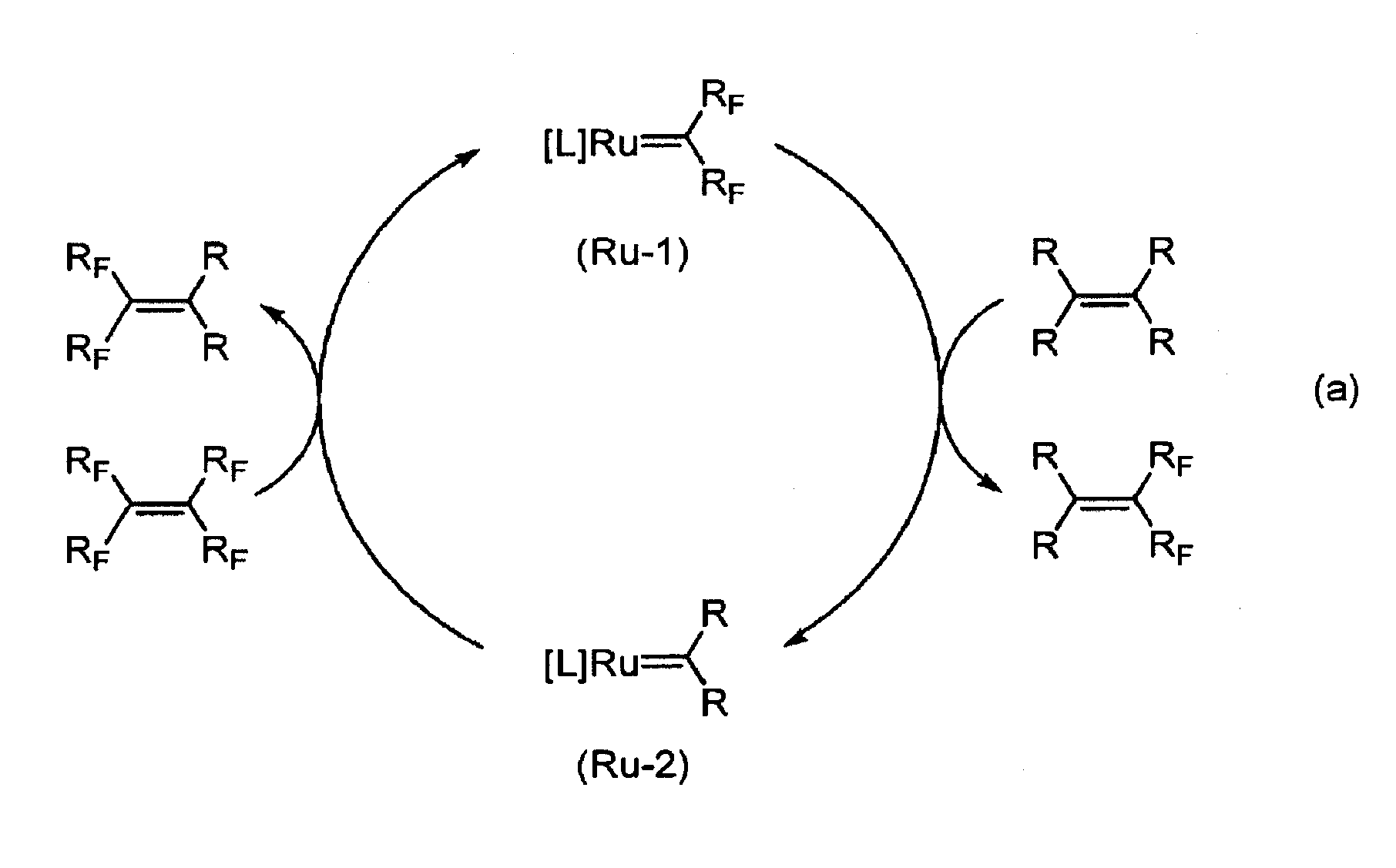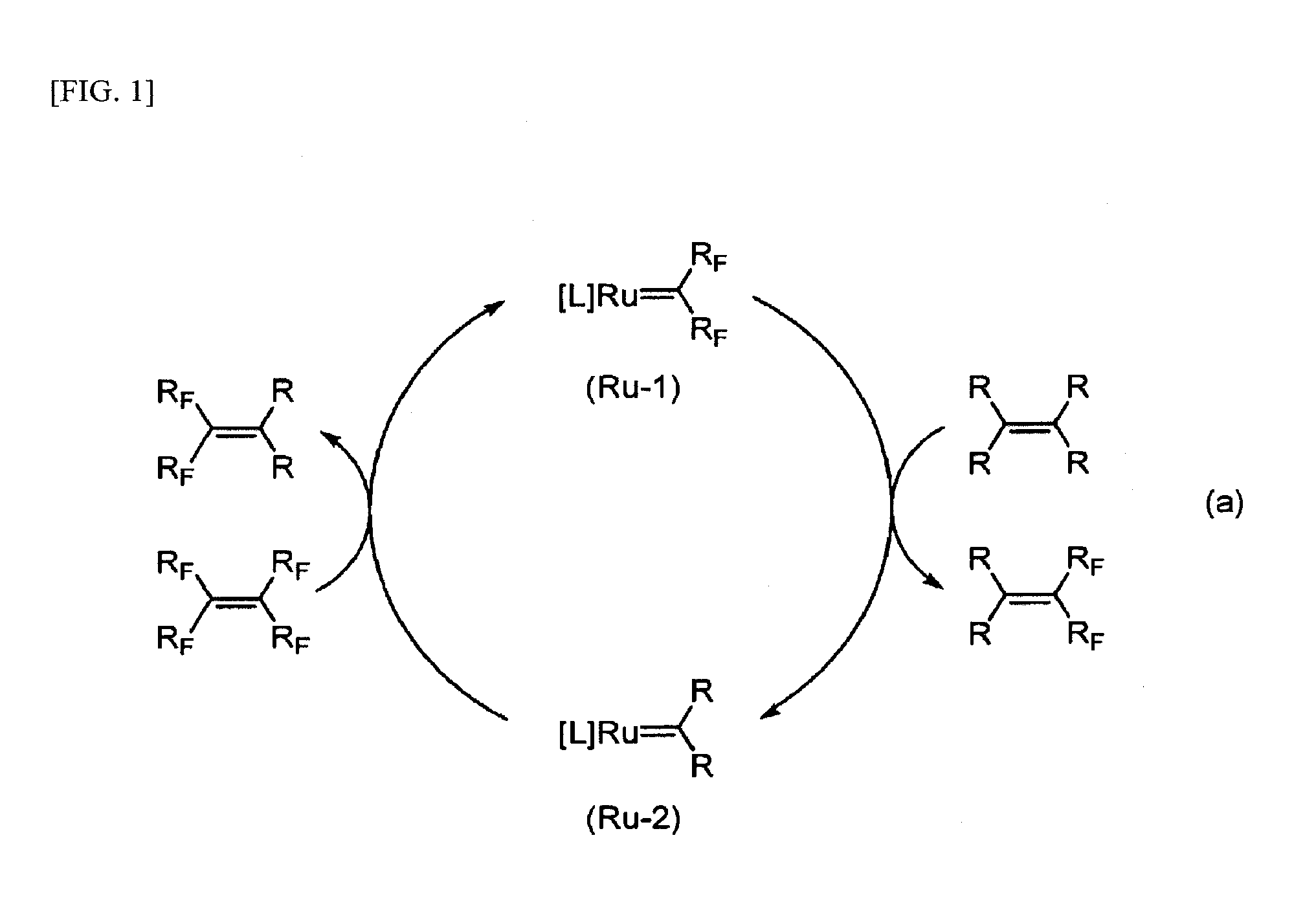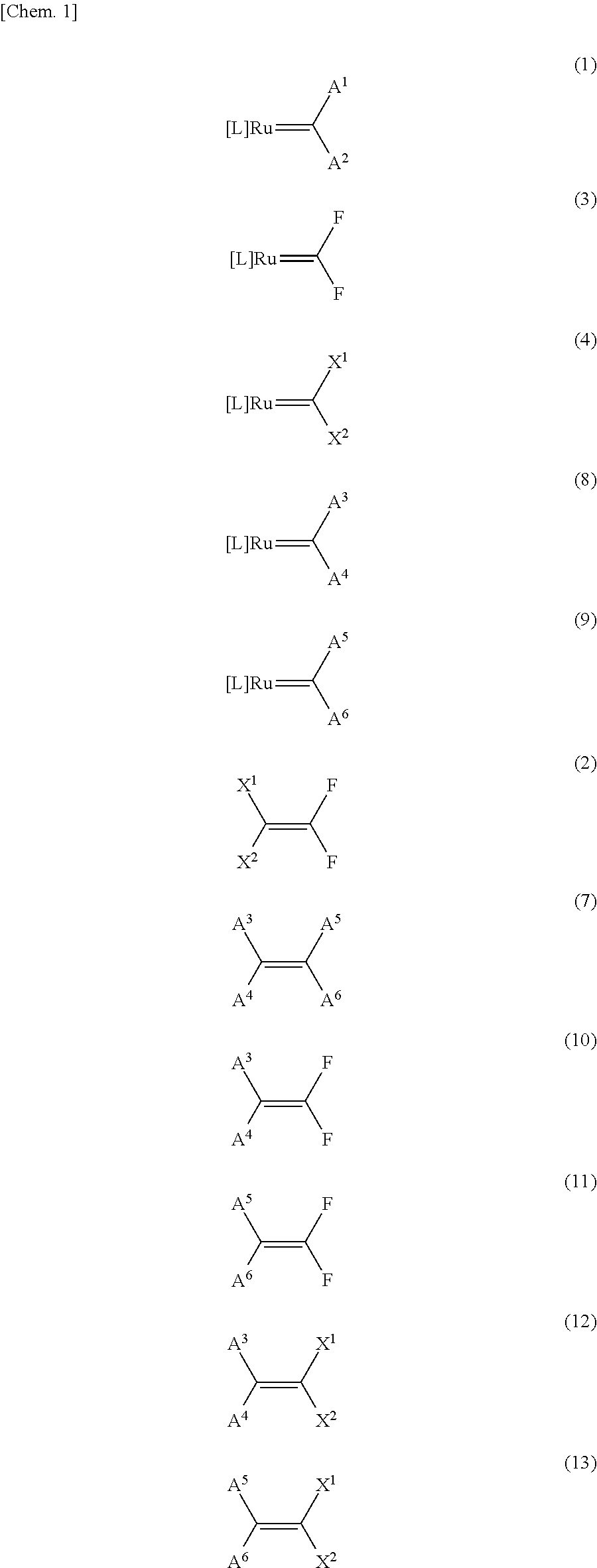Method for producing fluorine-containing olefin
a technology of fluorine and olefin, which is applied in the field of producing a fluorine-containing olefin, can solve the problems of low yield, low reactivity, and no method for simply and efficiently producing these compounds, and achieve the effect of simple and efficient production
- Summary
- Abstract
- Description
- Claims
- Application Information
AI Technical Summary
Benefits of technology
Problems solved by technology
Method used
Image
Examples
example 1
Metathesis of (1,3-dimesityl-4,5-dihydroimidazol-2-ylidene)(tricyclohexylphosphine)benzylidene ruthenium dichloride with tetrafluoroethylene
[0212]In a nitrogen atmosphere, (1,3-dimesityl-4,5-dihydroimidazol-2-ylidene)(tricyclohexylphosphine)benzylidene ruthenium dichloride (31.8 mg, 0.0375 mmol) and benzene-d6 (1.5 mL) were weighed and put into a 30-mL pressure-proof reactor. Cooled at −78° C., the content solution was frozen, and the internal pressure was reduced to about 1 mmHg. Subsequently, at room temperature, a mixed gas of tetrafluoroethylene / nitrogen (60 / 40 vol %) was introduced up to 1.7 atm (1.0 atom as a tetrafluoroethylene partial pressure).
[0213]The reactor was heated at 60° C., and the reaction was conducted at the temperature for 1 hour. After the completion of the reaction, NMR of the content liquid was measured to confirm the formation of β,β-difluorostyrene and (1,3-dimesityl-4,5-dihydroimidazol-2-ylidene)(tricyclohexylphosphine)difluoromethylidene ruthenium dichlo...
example 2
Metathesis of (1,3-dimesityl-4,5-dihydroimidazol-2-ylidene)(tricyclohexylphosphine)benzylidene ruthenium dichloride and chlorotrifluoroethylene
[0222]In a nitrogen atmosphere, (1,3-dimesityl-4,5-dihydroimidazol-2-ylidene)(tricyclohexylphosphine)benzylidene ruthenium dichloride (31.8 mg, 0.0375 mmol) and benzene-d6 (1.5 mL) were weighed and put into a 30-mL pressure-proof reactor. Cooled at −78° C., the content liquid was frozen, and the internal pressure was reduced to about 1 mmHg. Subsequently, at room temperature, chlorotrifluoroethylene was introduced up to 1.0 atm.
[0223]The reactor was heated at 60° C., and the reaction was conducted at the temperature for 1 hour. After the completion of the reaction, NMR and GC-MS of the content liquid were measured to confirm the formation of β,β-difluorostyrene and β-chloro-β-fluorostyrene (E / Z mixture).
[0224]The series of reaction is shown below.
(E)-β-chloro-β-fluorostyrene
[0225]1H-NMR (CDCl3, 300 MHz, tetramethylsilane): δ (ppm) 5.42 (1H, d...
example 3
Metathesis of (1,3-dimesityl-4,5-dihydroimidazol-2-ylidene)(tricyclohexylphosphine)benzylidene ruthenium dichloride and hexafluoropropylene
[0231]In a nitrogen atmosphere, (1,3-dimesityl-4,5-dihydroimidazol-2-ylidene)(tricyclohexylphosphine)benzylidene ruthenium dichloride (5.1 mg, 0.006 mmol) and m-xylylene-d10 (0.16 mL) with p-bis(trifluoromethyl)benzene (internal standard, 0.06 mmol) dissolved therein were weighed and put into a pressure-proof NMR tube. The content liquid was frozen by cooling with liquid nitrogen, and the internal pressure was reduced to about 1 mmHg. Subsequently, at room temperature, hexafluoropropylene (1.0 atm, 1.35 mL, 0.06 mmol) was introduced thereinto.
[0232]The NMR tube was heated at 60° C., and the reaction was conducted at the temperature for 1 hour. Subsequently, this was further heated at 100° C. for 1 hour and 140° C. for 1 hour in that order. The reaction proceeding was traced through NMR measurement to confirm the formation of β-fluoro-β-trifluorom...
PUM
| Property | Measurement | Unit |
|---|---|---|
| carbon number | aaaaa | aaaaa |
| carbon number | aaaaa | aaaaa |
| temperature | aaaaa | aaaaa |
Abstract
Description
Claims
Application Information
 Login to View More
Login to View More - R&D
- Intellectual Property
- Life Sciences
- Materials
- Tech Scout
- Unparalleled Data Quality
- Higher Quality Content
- 60% Fewer Hallucinations
Browse by: Latest US Patents, China's latest patents, Technical Efficacy Thesaurus, Application Domain, Technology Topic, Popular Technical Reports.
© 2025 PatSnap. All rights reserved.Legal|Privacy policy|Modern Slavery Act Transparency Statement|Sitemap|About US| Contact US: help@patsnap.com



